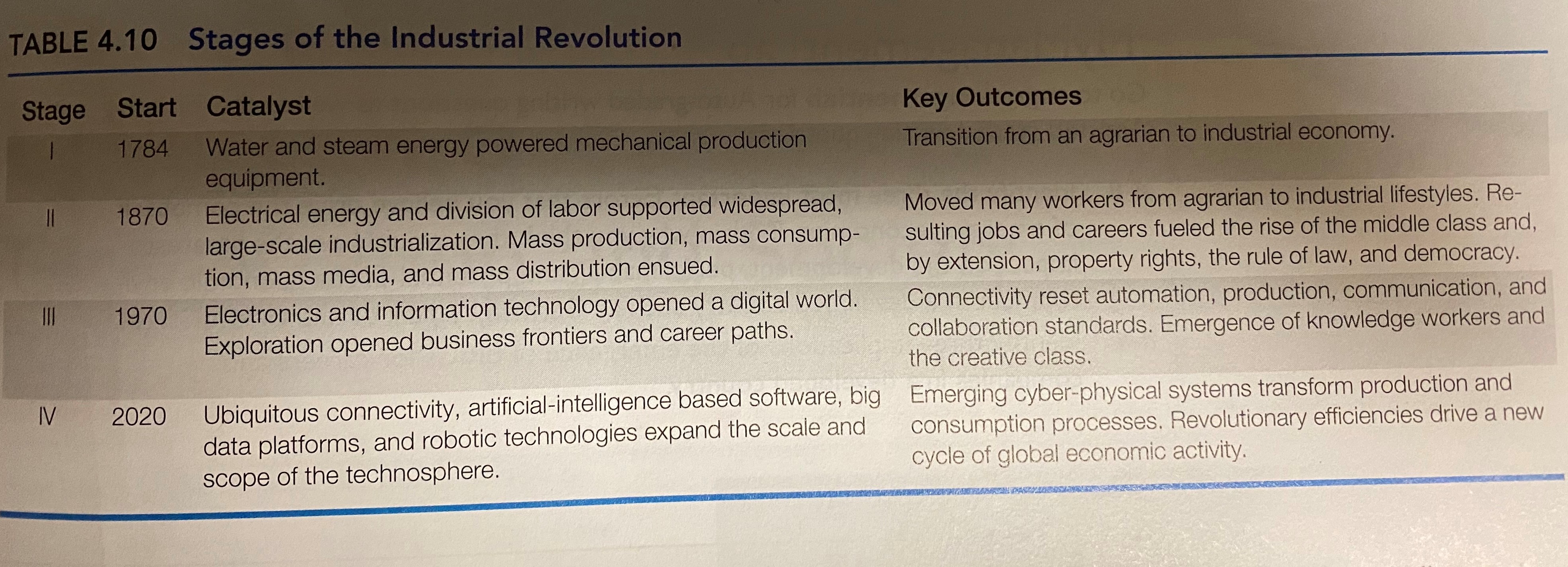Question
Case: Economic environments of the West: Problems, Puzzles, and the 4th Industrial Revolution Scanning emerging economies find enterprising companies, entrepreneurial citizens, and free-market advocates building
Case: Economic environments of the West: Problems, Puzzles, and the 4th Industrial Revolution
Scanning emerging economies find enterprising companies, entrepreneurial citizens, and free-market advocates building a brighter future. Scanning the developed economies of the West, such as Australia, Canada, Germany, and the United States, finds many chasing the same dream. But, facing different circumstances, developed economies face different futures. The sheer stature of Western markets? they account for roughly more than 60 percent of global GDP and are the makers of many world-class processes and products?pushes people to ask a very basic question. Namely, as production frontiers shift, market systems transform, and economic environments evolve, what then will the developed economies of the West do?
Persistent Problems and Troublesome Anomalies
Since 2008, real cumulative growth in the developed economies of the West has amounted to an anemic 5-6 percent; comparatively, China's GDP had risen about 70 percent while others, like India, Mali, Rwanda, and Turkmenistan, were not far behind.130 The West wrestles with growing unemployment, faltering productivity, slowing wage growth, and worsening income inequality.131 On the policy front, Zero Interest Rate Policies (ZIRP) implemented by anxious central bankers meant that interest rates were not just lo within the context of modern times?they were at the lowest levels in 5,000 years.132 Movement in some markets, notably Japan, Sweden, and Switzerland, to Negative Interest Rate Policy (NIRP) created the unprecedented situatio whereby investors paid governments to hold their money; in 2016, more than half of the world's developed-market sovereign debt traded at negative yields. Notwithstanding extraordinary monetary expansion in nearly every Western market, falling aggregate demand meant that, for the first time since the Great Depression, deflation, not inflation, posed the greatest risk. Countries, with few options for fighting deflation, resorted to competitive currency devaluations while central bankers speculated about "helicopter money."134 Public debt and unfunded non-debt liabilities grew ominously high, weighing down public-sector balance sheets. Fading public-sector investment, given growing debt burdens and falling aggregate demand, aggravated market shortfalls. Western nations' struggle with problems and anomalies, besides destabilizing their markets, threatened to undermine economic environments worldwide. In mid-2016, the IMF concluded that the prolonged slow growth had increased the risk that the developed economies of the West would fall into deflationary spirals while developing economies experienced secular stagnation. Correspondingly, for the seventh time since 2012, the IMF lowered its forecast of global growth and world trade. Increasingly, mindful of the comeback of emerging economies, managers ask what might become of the West. Would policy changes in Japan and the United States, for example, finally take hold and revitalize aggregate demand? Could monetary policy generate true organic growth? Would the many unemployed in Portugal, Italy, Greece, and Spain, among others, rejoin the workforce? How might consumers, from Australia to the United States, regain their mojo and resume spending? Might long-term stagnation, some added, be the price the West must pay for using extreme monetary and fiscal policies to pull consumer demand forward? And, ultimately, how might developed economies compete against their enterprising rivals in emerging economies? Looking here, there, and everywhere for answers, analyst projected wide-ranging scenarios. But, as growth stayed stuck in a rut and policymakers applied increasingly drastic tactics, attention turned to a provocative possibility. Might the economic environments of the West, given the emergent 4th Industrial Revolution, be in the early stage of a fundamental shift in how people work, consumers spend, companies compete, officials regulate, and markets perform?
The Promise and Peril of the 4th Industrial Revolution
Table 4.10 profiles the pivotal stages in how we have produced, consumed, and related to one another over the past 250 years or so. Thus far, every 60 years or so a wave of technology comes along that transforms economies and blazes new market frontiers. Today, the accelerating convergence of the physical and digital world ushers in the 4th Industrial Revolution. This era, even if it faintly echoes precedent, will introduce radically different tools and techniques that require fundamentally rethinking the idea of work, productivity, and prosperity. The "Internet of things" will digitize the physical world, continuously tracking data feeds among sensors loaded in billions of objects. Besides tracking everything, we will synthesize ingenious materials and redesign production and consumption systems to maximize resource efficiencies. 3-D printing, as "one of the pillars of the future of manufacturing," signals that big factories may be unnecessary to achieve efficient production. The falling cost of making much smaller batches of a much wider variety of products moves MNEs to scenarios where they will be able to make items tailored precisely to a customer's request. Robotic platforms will support small-scale factories, located anywhere and everywhere in the world, that efficiently enable mass customization. Already, robot makers contend that machines are more cost-effective than humans in an expanding range of applications, suggesting that "We're on the cusp of completely changing manufacturing and distribution. I think it's not as a singular event, but it will ultimately have as big an impact as the Internet."137 Finally, cheap smartphones, equivalent to supercomputers a generation ago and increasingly in everyone's pocket, will turbocharge the technosphere.
Timing Revolutions
Preceding Industrial Revolutions radically reset economic logics, marketplace activities, and workplace standards. Earlier, for instance, machine power replaced farm labor?in 1900, 41 percent of the U.S. labor force was employed in agriculture; today, it's less than 2 percent. Then, automation replaced factory labor?in 1965, 28 percent of the U.S. labor force was employed in manufacturing; today, it's less than 9 percent. Now, besides farming and manufacturing jobs, business processes, historically the realm of white-collar jobs, are becoming "mechanized" via robots powered by artificial intelligence. Workers in a far wider set of professions (accounting, education, and medicine) and industries (transportation, manufacturing, energy) face growing job insecurity. Some anticipate artificial intelligence systems, in the form of frightfully powerful thinking machines applying increasingly sophisticated learning-based algorithms, joining, and perhaps replacing, upper management.138 Collectively, forecasts are dire: estimates see nearly half of the jobs in the developed economies of the West at high risk from the changes underway in digitization and automation.139 Unlike before, where these shifts unfolded over three or four generations, the West faces the unprecedented challenge of experiencing this shift in a single generation. Already, evidence indicates big change: a generation ago, every million-dollar increase in GNP in the West generated roughly 10 jobs; now, it generates 1 or 2.
What Next?
By definition, a revolution radically disrupts, if not resets, existence. In the economic realm, the 4th Industrial Revolution heralds such a change; robots, 3-D printing, artificial intelligence, infinite connectivity, to say nothing of nanotechnology, implantable devices, wearable tech, and sentient machines, will reset the dimensions and dynamics of economic environments. Expectedly, workers, consumers, companies, citizens, regulators, and governments throughout the developed markets of the West, already wrestling with puzzling problems and troublesome anomalies, wondered what it all meant to their understanding of economic environments.

Step by Step Solution
There are 3 Steps involved in it
Step: 1

Get Instant Access to Expert-Tailored Solutions
See step-by-step solutions with expert insights and AI powered tools for academic success
Step: 2

Step: 3

Ace Your Homework with AI
Get the answers you need in no time with our AI-driven, step-by-step assistance
Get Started


